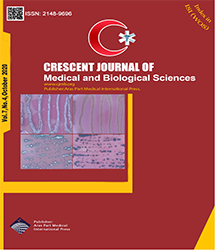
| Original Article | |
| Evaluation of Postoperative Shivering With Remifentanil-Propofol Intravenous Anesthesia in Ambulatory Gynecologic Procedures: The Relationship With Intraoperative Core Body Temperature | |
| Farnaz Moslemi1, Elham Gadamkheyr1, Mona Gaderi2 | |
| 1Women’s Reproductive Health Research Center, Department of Anesthesiology, Alzahra, Teaching Hospital, School of Medicine, Tabriz University of Medical Sciences, Tabriz, Iran 2Zanjan University of Medical Sciences, Tabriz, Iran |
|
|
CJMB 2020; 7: 527-532 Viewed : 4024 times Downloaded : 3545 times. Keywords : Post-anesthetic shivering, Remifentanil, Fentanyl, Propofol |
|
| Full Text(PDF) | Related Articles | |
| Abstract | |
Objectives: Postanesthesia shivering (PAS) is a frequent side effect of general anesthesia and one of the leading causes of patients" discomfort after recovery from anesthesia, especially in an ambulatory setting. Remifentanil is reported to have an increased incidence of PAS compared to other analgesics maybe due to several ways that are unrelated to the patient"s core body temperature variations. The aim of this study was to evaluate the effects of remifentanil versus fentanyl on postoperative shivering and its relationship with intraoperative hypothermia. Materials and Methods: Accordingly, 100 patients scheduled for outpatient gynecologic procedures were studied in two randomly assigned groups. All patients received total intravenous anesthesia for induction and maintenance with remifentanil-propofol and fentanyl-propofol in remifentanil and fentanyl groups, respectively. The incidence and severity of shivering, as well as core body temperature, hemodynamic variations, and probable postoperative complications were evaluated and recorded based on the aim of the study. Results: Based on the results, there were no significant differences in demographic data. On the other hand, the incidence and severity of shivering were significantly higher in the remifentanil group compared to the fentanyl group (P < 0.001) although core body temperatures did not differ between the two groups (P > 0.05). Finally, no significant difference was observed in hemodynamic changes and other postoperative complications between the two groups (P > 0.05). Conclusions: In general, remifentanil is a very short-acting and safe opioid for ambulatory procedures. However, it is associated with a higher incidence and severity of shivering as compared to other opioids unrelated to intraoperative hypothermia. Thus it must be noted that some strategies are needed to prevent this complication. |
Cite By, Google Scholar
Online Submission System
 CJMB ENDNOTE ® Style
CJMB ENDNOTE ® Style
 Tutorials
Tutorials
 Publication Charge
Medical and Biological Research Center
About Journal
Publication Charge
Medical and Biological Research Center
About Journal
Aras Part Medical International Press Editor-in-Chief
Arash Khaki
Deputy Editor
Zafer Akan


















